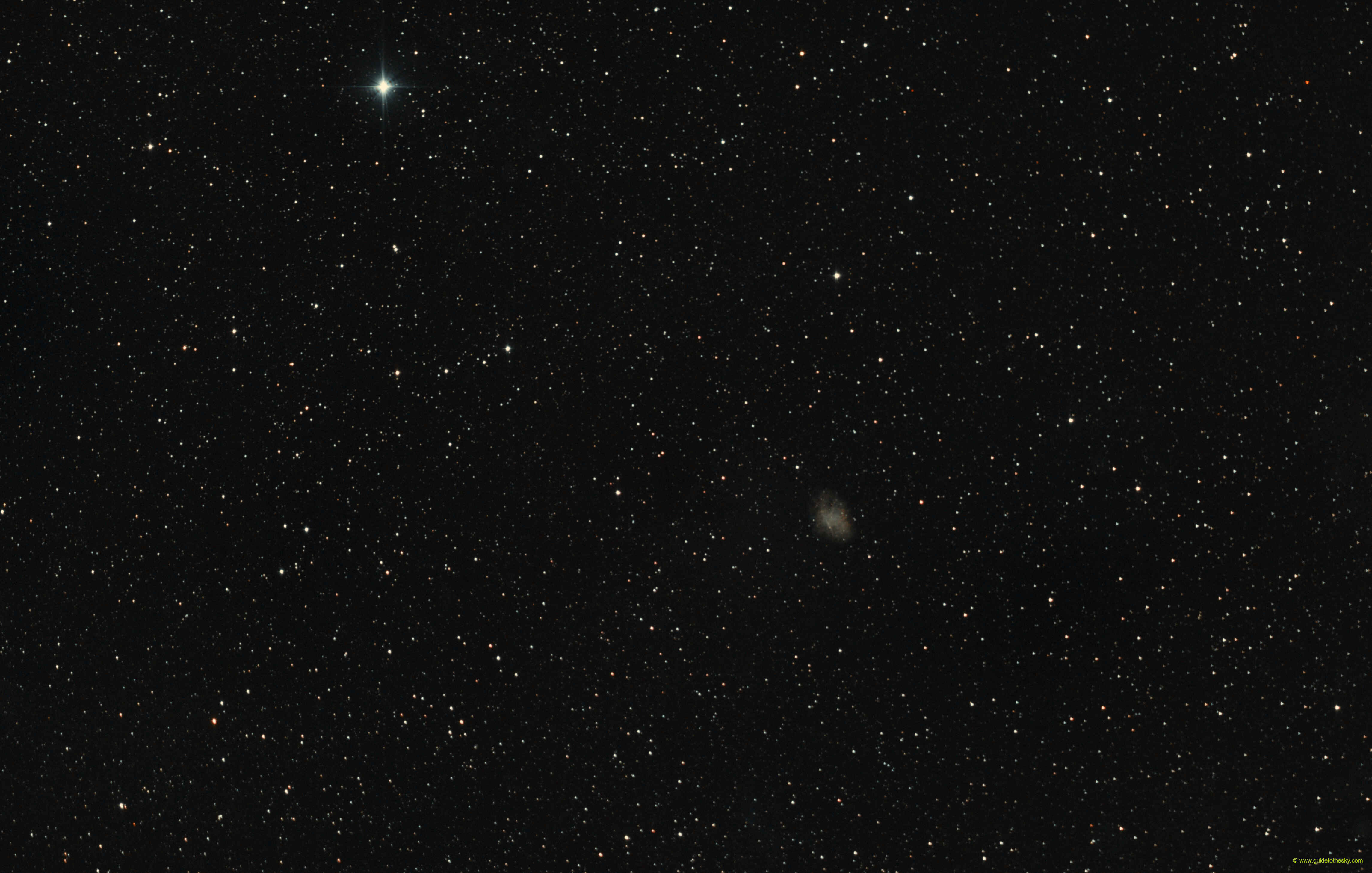Messier 1 - Taurus

M1 tiene algunas carácterísticas únicas, además de ser el primer objeto del catálogo Messier también es una nebulosa planetaria cuya formación está documentada: es conocido que en el año1054, unos astrónomos chinos registraron una estrella invitada o "Nova" mucho más brillante que las demás y que desapareció al cabo de unos pocos meses.
El fenómeno debió haber sido expectacular, se especula que alcanzó una magnitud aparente aproximada de -6, más de 2.5 veces el brillo de Venus en su momento de mayor brillo.
Hoy en día, en ese mismo lugar podemos observar los remanentes de aquella catástrofe cósmica, una nebulosa plagada de filamentos que se expanden y acabarán enriqueciendo el medio interestelar con nuevos elementos químicos que darán lugar a la próxima generación de estrellas y posiblemente, a la vida.
Messier 1 es lo que llamamos una nebulosa planetaria, sabemos que brilla desde {{object[0].M1.mesDistances[0].dist }} {{ object[0].M1.mesDistances[0].unit }}, es decir unos 6500 años luz y que en su centro alberga una estrella de neutrones o púlsar que gira a más de 30 revoluciones por segundo.
M1 - Nebulosa del cangrejo - en la IA
Messier 1 (M1), also known as the Crab Nebula, is a fascinating and well-studied supernova remnant located in the constellation Taurus. Here's a breakdown of its key features and why it's so important:
Key Characteristics:
- Type: Supernova Remnant (Specifically, a Pulsar Wind Nebula)
- Distance: Approximately 6,500 light-years from Earth
- Diameter: Roughly 11 light-years across
- Apparent Magnitude: About 8.4 (visible with binoculars under very dark skies)
- Location: Constellation Taurus, near the star Zeta Tauri
- Age: Roughly 970 years (supernova observed in 1054 AD)
- Central Object: The Crab Pulsar, a rapidly rotating neutron star
What Makes the Crab Nebula Important?
- Historical Significance: It's linked to a historical supernova event. Chinese astronomers recorded a "guest star" that was visible even during the day for several weeks in 1054 AD. This record helped modern astronomers identify the Crab Nebula as the remnant of that event.
- Supernova Remnant: It is a prime example of what happens after a massive star explodes as a supernova. The ejected material is expanding into space, interacting with the interstellar medium.
- The Crab Pulsar: At the heart of the nebula lies the Crab Pulsar. This neutron star spins incredibly rapidly (about 30 times per second) and emits powerful beams of radiation (radio waves, X-rays, gamma rays) from its magnetic poles. As the pulsar spins, these beams sweep across our line of sight, causing a pulsing effect.
- Pulsar Wind Nebula: The Crab Nebula is classified as a "pulsar wind nebula." The pulsar's strong magnetic field and rapid rotation accelerate particles to near-light speed. These particles emit synchrotron radiation as they spiral around magnetic field lines, producing the nebula's characteristic glow, particularly bright in X-rays and radio waves. This is distinct from thermal supernova remnants where the emission is primarily from heated gas.
- Energy Source: The Crab Pulsar is the powerhouse that drives the nebula's activity. Its energy output is tremendous, constantly injecting energy into the surrounding gas and dust, causing it to glow and expand.
- Observational Target: It's a favorite target for astronomers using telescopes across the electromagnetic spectrum (radio, infrared, visible light, ultraviolet, X-rays, and gamma rays). This allows for a comprehensive understanding of the physics and processes occurring within the nebula.
- Laboratory for Extreme Physics: The Crab Nebula is an extreme environment where particles are accelerated to incredibly high energies, and magnetic fields are immensely strong. It provides a natural laboratory for studying fundamental physics under conditions that cannot be replicated on Earth.
- Calibration Source: Its brightness and stability across a broad range of wavelengths make it a valuable calibration source for astronomical instruments.
Appearance:
In visual telescopes, the Crab Nebula appears as a faint, hazy, and mottled object. Its filamentary structure, composed of ionized gas, is more easily observed in photographs taken with long exposures. The Crab Pulsar is too faint to be seen with most amateur telescopes.
In summary, the Crab Nebula is a celestial treasure that provides invaluable insights into the life cycle of massive stars, the physics of supernova explosions, and the behavior of matter under extreme conditions.
Más información sobre Messier 1 en NASA/IPAC.
Mapa alrededor de Messier 1
Otros identificadores de M1:
"4FGL J0534.5+2201i" ,"2AGL J0534+2205" ,"eHWC J0534+220" ,"2HWC J0534+220" ,"3HWC J0534+220" ,"1RXS J053431.2+220218" ,"SRGA J053431.8+220103" ,"PCCS2 030 G184.54-05.78","SNR G184.6-05.8" ,"1H 0531+219" ,"1M 0531+219" ,"2C 481" ,"2E 1309" ,"2U 0531+22" ,"3A 0531+219" ,"3C 144" ,"3C 144.0" ,"3CR 144" ,"3U 0531+21" ,"4C 21.19" ,"4U 0531+21" ,"AJG 1" ,"CTA 36" ,"CTB 18" ,"Cul 0531+21" ,"Cul 0531+219" ,"DA 179" ,"DB 38" ,"H 0534+21" ,"H 0531+219" ,"IRAS 05314+2200" ,"LBN 833" ,"LBN 184.62-05.65" ,"M 1" ,"Mills 05+2A" ,"NAME CRAB NEB" ,"NAME Crab" ,"NAME Crab Nebula" ,"NAME Tau A" ,"NAME Taurus A" ,"NGC 1952" ,"NRAO 214" ,"NRL 2" ,"PKS 0531+219" ,"SH 2-244" ,"SIM 0531+21.0" ,"VRO 21.05.01" ,"X Tau X-1" ,"X Tau XR-1" ,"[BM83] X0531+219" ,"[DGW65] 25" ,"[PT56] 5" ,"1ES 0532+21.5" ,"2E 0531.5+2159" ,"PBC J0534.5+2201" ,"SWIFT J0534.6+2204" ,"SWIFT J0534.5+2200" ,"GRS G184.60 -05.80" ,"W 9" ,"NVSS J053428+220202" ,"ARGO J0535+2203" ,"3FGL J0534.5+2201i" ,"TeV J0534+220" ,"3FHL J0534.5+2201" ,

